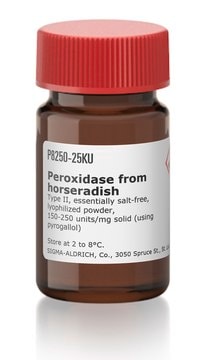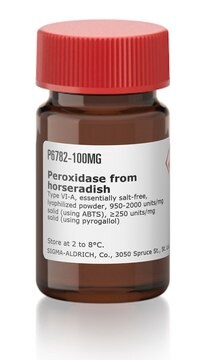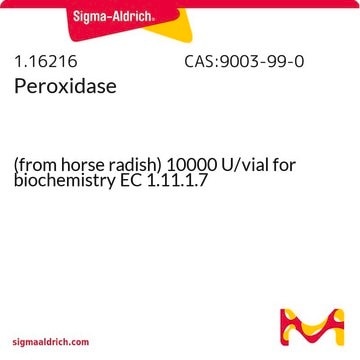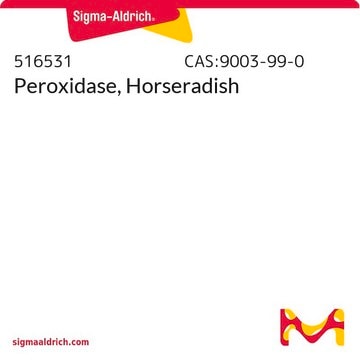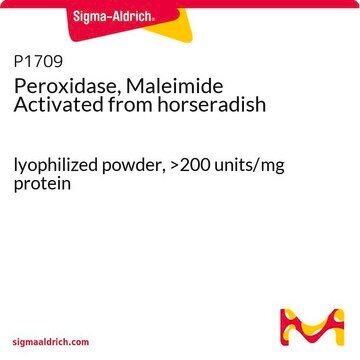The optimal pH range for product P8375 is 6.0 - 6.5.
Kluczowe dokumenty
P8375
Peroxidase from horseradish
Type VI, essentially salt-free, lyophilized powder, ≥250 units/mg solid (using pyrogallol)
Synonim(y):
Detection Enzyme, HRP, Peroxidase, Donor:hydrogen-peroxide oxidoreductase, Horseradish peroxidase
Wybierz wielkość
293,00 zł
Wybierz wielkość
About This Item
293,00 zł
Polecane produkty
typ
Type VI
Formularz
essentially salt-free, lyophilized powder
aktywność właściwa
≥250 units/mg solid (using pyrogallol)
masa cząsteczkowa
~44 kDa
rozpuszczalność
0.1 M phosphate buffer: soluble 10 mg/mL, clear, orange to red (pH 6.0)
stosunek absorbancji
RZ 2.5-4.0
Zastosowanie
diagnostic assay manufacturing
temp. przechowywania
2-8°C
ciąg SMILES
[O+H2]O[O-]
InChI
1S/H2O3/c1-3-2/h1-2H
Klucz InChI
JSPLKZUTYZBBKA-UHFFFAOYSA-N
Szukasz podobnych produktów? Odwiedź Przewodnik dotyczący porównywania produktów
Powiązane kategorie
Opis ogólny
Zastosowanie
Działania biochem./fizjol.
Definicja jednostki
Komentarz do analizy
Inne uwagi
Inhibitor
substrat
Hasło ostrzegawcze
Danger
Zwroty wskazujące rodzaj zagrożenia
Zwroty wskazujące środki ostrożności
Klasyfikacja zagrożeń
Resp. Sens. 1
Kod klasy składowania
11 - Combustible Solids
Klasa zagrożenia wodnego (WGK)
WGK 1
Środki ochrony indywidualnej
Eyeshields, Gloves, type N95 (US)
Wybierz jedną z najnowszych wersji:
Certyfikaty analizy (CoA)
Nie widzisz odpowiedniej wersji?
Jeśli potrzebujesz konkretnej wersji, możesz wyszukać konkretny certyfikat według numeru partii lub serii.
Masz już ten produkt?
Dokumenty związane z niedawno zakupionymi produktami zostały zamieszczone w Bibliotece dokumentów.
Klienci oglądali również te produkty
Produkty
Discover our peroxidase from horseradish enzymes, products, substrates, and inhibitors for your ELISA, immunoassay, and protein application needs.
Odkryj naszą peroksydazę z enzymów chrzanowych, produkty, substraty i inhibitory do testów ELISA, testów immunologicznych i zastosowań białkowych.
Protokoły
Reinheitszahl (RZ) is the ratio of absorbance due to hemin (A403, Soret region) to absorbance due to protein (A275).
To standardize a procedure for the assay of Peroxidase using 2,2'-Azino-bis(3-Ethylbenzthiazoline-6-Sulfonic Acid) as a substrate.
This procedure is for the determination of Peroxidase enzymatic activity using Pyrogallol as the substrate.
Ta procedura służy do oznaczania aktywności enzymatycznej peroksydazy przy użyciu pirogallolu jako substratu.
-
What is the optimal pH range of Peroxidase from horseradish, Product P8375?
1 answer-
Helpful?
-
-
What is the Department of Transportation shipping information for this product?
1 answer-
Transportation information can be found in Section 14 of the product's (M)SDS.To access the shipping information for this material, use the link on the product detail page for the product.
Helpful?
-
-
What can you tell me about the stability of Peroxidase from horseradish, Product P8375, (as is, in suspension and in solution)?
1 answer-
This product is stable as a powder, kept refrigerated. See the certificate of analysis for a lot-specific recommended retest date. It is also stable as a crystalline suspension of 3.2 M (NH4)2SO4 solution containing potassium phosphate buffer, pH 6.0 (see Product No. P6140). It is reasonably stable in solution in phosphate buffer. We have found that at 10 mg/mL in 0.1 phosphate buffer, pH 6.0, solutions kept frozen at -20°C lose less than 2% of their activity per week.
Helpful?
-
-
How do I convert units of Peroxidase from horseradish, Product P8375, to solid?
1 answer-
The activity listed on the Certificate of Analysis for each lot can be used to convert from units to milligrams of solid.
Helpful?
-
Active Filters
Nasz zespół naukowców ma doświadczenie we wszystkich obszarach badań, w tym w naukach przyrodniczych, materiałoznawstwie, syntezie chemicznej, chromatografii, analityce i wielu innych dziedzinach.
Skontaktuj się z zespołem ds. pomocy technicznej
